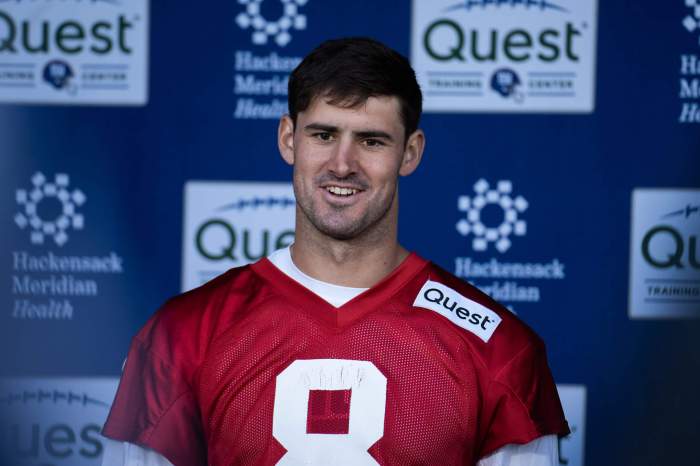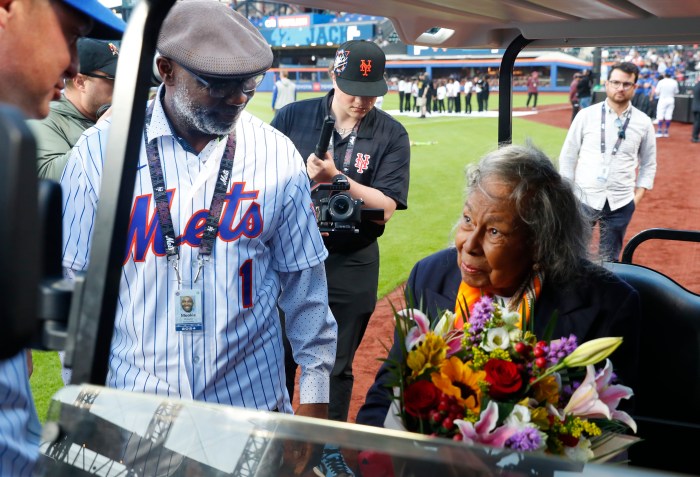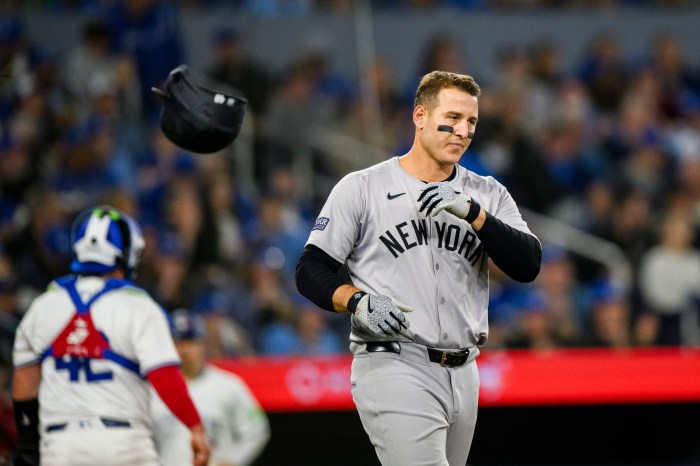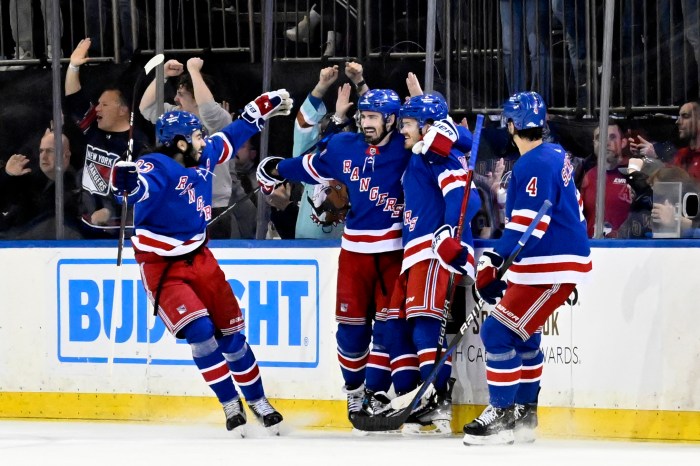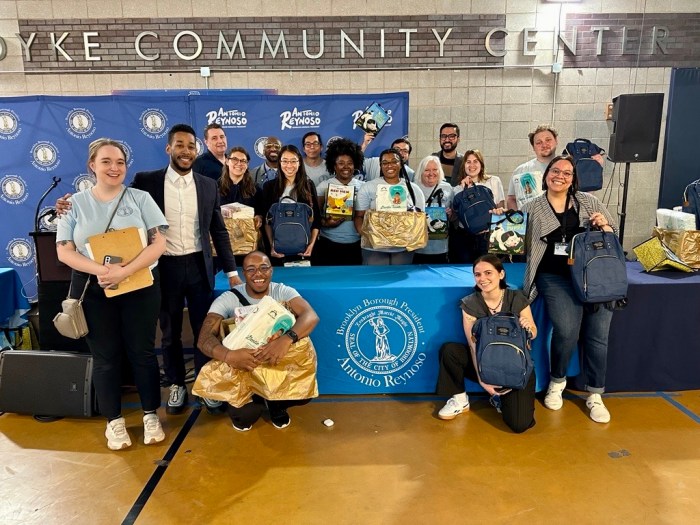
Derek Jeter’s yearning to wear pinstripes was born of childhood summers watching the Yankees. Though raised in Kalamazoo, Michigan, Jeter spent much of the baseball season with his grandparents in West Milford, N.J.
Jeter’s maternal grandmother, Dorothy Connors, nurtured the child’s love of the team by making Yankee Stadium a frequent destination.
Jeter’s dream reached fruition on June 1, 1992, when the Yankees selected the high school shortstop with the sixth pick in the first round of the amateur draft.
Yes, five teams passed on Derek Jeter. And that was fine by him.
“It’s all I’ve ever wanted,” he said this past week, “so I couldn’t picture anything else. It was perfect for how it worked out.”
The Yankees held their collective breath 22 years ago, knowing they were fifth in line for the player they had targeted.
“We were like, ‘Oh, God, if we feel this way about him, I’m sure other people do, too,’ ” recalled Bill Livesey, the Yankees’ scouting director in 1992.
More than two decades later, decision-makers from the teams that passed on the future Hall of Fame player looked back on that draft.
Regrets, they have a few
“Five of us geniuses passed him over,” former Astros general manager Bill Wood said.
Wood’s team had the first overall pick in 1992 and, despite the strong protestations of Astros scout and Hall of Fame pitcher Hal Newhouser, the Astros chose outfielder Phil Nevin. “Jeter is the story that never goes away,” Wood said. “God bless him, I love the career he’s had.”
Sadly for Wood, it wasn’t in Houston. Despite Jeter’s feeling for the Yankees, if the Astros had chosen him, he likely would have signed with Houston rather than go to college. “I would assume so,” he said. “If you want to start your career in baseball and you are drafted as the No. 1, I would assume you go start your career.”
Dan O’Brien Jr., then Houston’s scouting director, wonders what might have been. “Every now and then, there’s a fleeting thought of what it would have been like to have Jeter at shortstop, who’s a Hall of Famer, and a likely Hall of Famer at second base in Craig Biggio,” O’Brien said.
O’Brien now works alongside Dick Groch — the former Yankees scout responsible for discovering Jeter at Kalamazoo Central High School — in the Brewers’ organization.
“We kid one another,” O’Brien said. “But the bottom line is Dick got his man and he deserves all the accolades.”
What made Jeter so desirable as a prospect? In his senior season of high school, he hit .508 with a .637 on-base percentage and an .831 slugging percentage. He had four home runs and 23 RBIs, was 12-for-12 on stolen-base attempts and struck out once all season.
Jeter was named the top high school player in 1992 by the American Baseball Coaches Association. He also received Gatorade and USA Today honors as the top player.
If there was talk that Jeter might pass on the majors to play ball in college for Michigan, there was no concern on the part of the Yankees.
Said Groch, “His mother and father both said, ‘He wants to play professional baseball.’ I was certain about his signability. His father, Charles, was very candid: ‘We have our price. He wants to play professional baseball. If you meet our price, he is going to do that.’ ”
Picked before Jeter
NO. 1 PHIL NEVIN had a 12-year career but played in only 18 games for the Astros. “There are very few can’t-miss guys,” Nevin said. “And a lot of those can’t-miss guys seem to miss all the time. I can sit down now and tell my kids I was drafted in front of a Hall of Famer.”
NO. 2. PAUL SHUEY: The Indians had the second pick and chose the University of North Carolina pitcher. “When I saw Derek Jeter, he had hurt his ankle pretty badly,” said former scouting director Mickey White, who had signed Manny Ramirez and Rob Dibble. “While I liked [Jeter], Shuey for me was kind of what we needed.” White added, “I wished I had seen Derek healthy.”
Said Shuey, “At the end of the day, I was probably the best arm in the draft, and that’s why they picked me. They thought they could take that arm and turn it into a starter that could really be something special for them, or have me as a closer. I didn’t turn out the way they wanted but I ended up being a solid major-league player.”
NO. 3: B.J. WALLACE: The Montreal Expos took the Mississippi State and Barcelona Olympics star pitcher with the third pick. He had arm problems and never made it to the majors. Through an Orioles spokesman, former Expos general manager Dan Duquette, now with Baltimore, summed up the pick succinctly: “Obviously, we didn’t give it enough consideration.”
NO. 4. JEFFREY HAMMONDS: With the fourth pick, the Orioles took the Stanford outfielder, who grew up a Yankees fan in Scotch Plains, New Jersey. “My aunt lived on the Grand Concourse. I wanted to be a Yankee,” he said. “It wouldn’t have bothered me if I went to the sixth spot, 10th spot, 12th spot.”
He said the Orioles gave him a bonus of $975,000. Jeter received a reported $700,000. “I would have taken whatever they would have given me,” Hammonds said of the Yankees.
Then-Orioles scouting director Gary Nickels said, “We had had such great success with college players — Mike Mussina, Pete Harnisch, Ben McDonald — we were more orientated toward college people at that time. Jeter was our highest high school player at the time, but we liked Jeffrey Hammonds.”
Nickels conceded that when a missed pick goes on to have a career like Jeter’s, “you have the sense to some degree” that it was a missed opportunity but that “it is part of the business.”
Nickels, now a scout with the Dodgers, might have picked himself a future Hall of Fame pitcher with the drafting of Clayton Kershaw seventh in 2006. Said Nickels, “You could go to any of those six teams and ask, ‘Do [you] feel anything?’ ”
NO. 5. CHAD MOTTOLA: The Reds had the fifth pick and it appeared everyone but the final decision-maker wanted Jeter. Gene Bennett, the scout who had discovered stars Barry Larkin, Paul O’Neill, Chris Sabo and Eric Davis, was the most unnerved by the Reds’ decision to bypass Jeter.
Bennett said he wanted Jeter and no one else, but the Reds chose outfielder Mottola.
“I felt like I was going to have a heart attack,” Bennett said. “I was shocked when we didn’t take him. There were no words to use. The damage was done.”
Bennett said he had Jeter work out as an outfielder in a pre-draft gathering. “I’m telling you he looked like Willie Mays going after the ball,” he said. “Derek could have been a Hall of Famer in centerfield.”
Bennett said Jeter told him he would play center if the Reds wanted Larkin to remain at shortstop.
Bob Quinn, the Reds’ general manager at the time, said he left it up to scouting director Julian Mock to make the selection.
“When the higher-ups start messing with the draft, they can mess it up royally,” Quinn said. “You have to leave it up to your scouting director and your scouts.” He said owner Marge Schott was not involved. “Marge,” he said, “wouldn’t have known a baseball player from a pogo stick.”
Mock, 85, said, “Well, we had a Hall of Fame shortstop in the making [Larkin]. We needed a power outfielder and that’s the reason we passed on him. As I look back now, I don’t know that [Jeter] would have ever made the big leagues with the Reds because he made quite a few errors [in the minors]. A lot of people would bury a guy like that.”
In Class A, Jeter made a South Atlantic League-record 56 errors in 1993.
Jim Bowden, who was about to become the Reds’ new GM, added, “It was a bizarre twist of power. Marge Schott had Julian Mock report to her rather than to Bob Quinn. It was Julian’s draft. The decision was his. He had full power. Had she hired Gene Bennett as scouting director, Jeter would have been a Cincinnati Red.”
Mottola, now a hitting coordinator for the Rays, played only 35 games for the Reds. He said being drafted by the Reds over Jeter “gives players something to get on me about. It’s actually enjoyable at this point. It all worked out the way it worked out.”
Uncertain that Jeter would be available with the Yankees picking sixth, Groch had a fellow scout poised to go for high school pitcher James Pittsley. “We had Joe DiCarlo sitting in front of Jim Pittsley’s house waiting,” he said. “He was going to go into the house.” Pittsley went to the Royals with the 17th pick and was 7-12 in a four-year career. “I’m from Podunk, Pennsylvania, so just to be drafted was something for me,” Pittsley said. “It would have been great, something special to have been drafted by the Yankees.”
Sixth sense
When the Reds passed on Jeter, the Yankees were in. “We were an awfully happy room,” Livesey said.
Earlier, owner George Steinbrenner had to be convinced. “He wasn’t really high on high school kids,” Livesey said. “We assured him he would be in the big leagues in four years. George reminded, ‘If not, it’s your you-know-what.’ ”
Groch said the contract was signed after one final request by Jeter. “He wanted $50,000 worth of baseball equipment divided up to a number of entities in Kalamazoo,” Groch said.
Said Jeter, “That was an important part of it. I wanted to give back to where I came from.”
Now, at the age of 40 and in his final season, the owner of five World Series rings has come full circle. Just as he was drafted sixth overall, he needs only 34 hits to move into sixth place on the career list after producing 3,397 of them.
Jeter was asked if his career would have been the same if he had played elsewhere.
He replied, “If I didn’t come here, would it be the same Yankees?”










